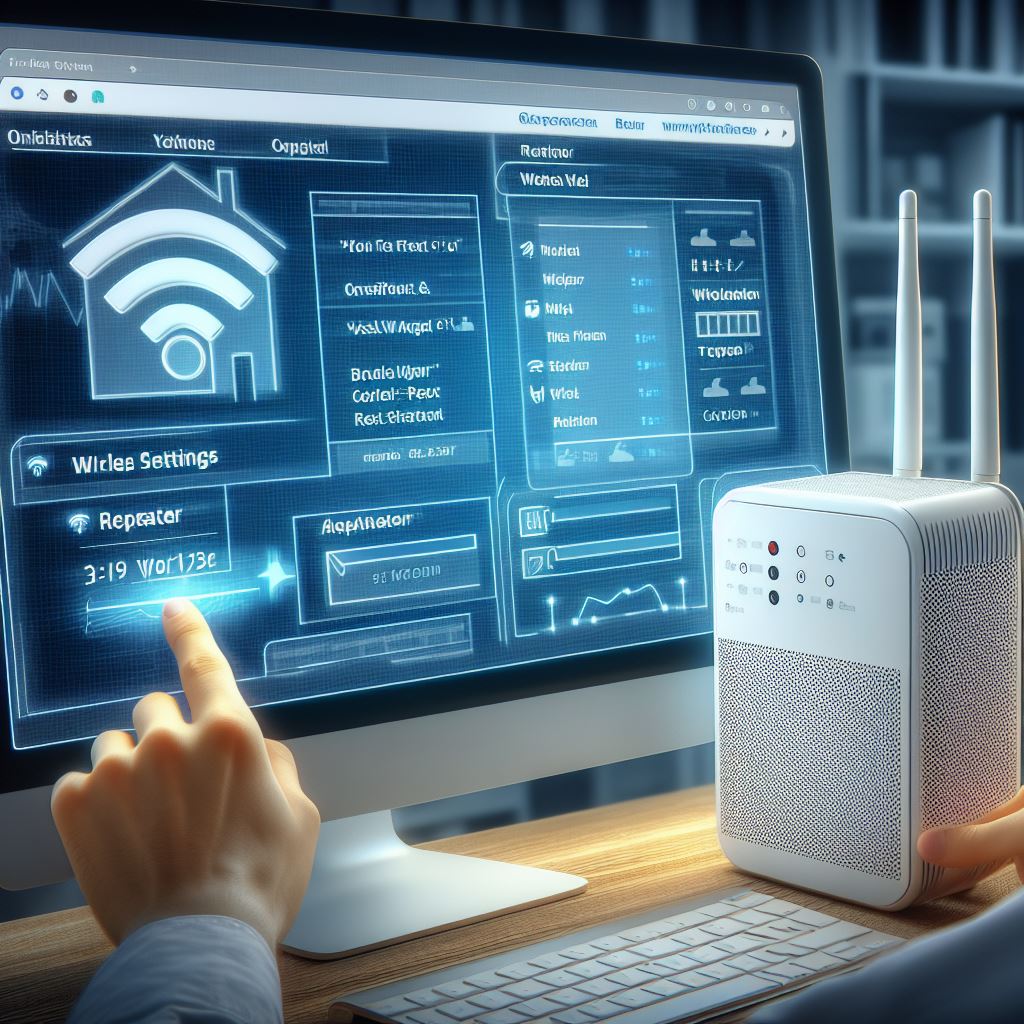Learn how to Configure TP Link TL WR941nd Router As A Repeater with our step-by-step guide. Extend your Wi-Fi coverage effortlessly and boost your network signal strength today!
Introduction
Configuring your TP-Link TL-WR941ND router as a repeater can significantly enhance your Wi-Fi network’s coverage and performance. By setting it up as a repeater, you can effectively extend the range of your existing wireless network, ensuring seamless connectivity in areas that were previously out of reach. In this guide, we’ll walk you through the process step by step, making it easy for you to maximize the potential of your router and enjoy a stronger, more reliable wireless connection throughout your home or office.
Repeater Mode
Repeater Mode is a functional setting available on many wireless routers and access points, designed to extend the coverage of an existing wireless network. This mode enables a device to capture, amplify, and retransmit signals from a primary wireless router to areas where the network coverage is weak or nonexistent. By functioning as a bridge between the main router and the devices that are out of the primary router’s range, Repeaters help in creating a larger network area, providing users with improved signal strength and quality over greater distances.
The primary objective of Repeater Mode is to eliminate dead zones in homes, offices, or any environment where structural elements, distance, or interference weakens wireless signals. It’s particularly useful in large or multi-story buildings where walls, floors, and other physical obstructions can severely degrade Wi-Fi performance.
When a router or an access point is configured in Repeate Mode, it no longer acts merely as a conduit for direct internet connections. Instead, it takes on a dual role: receiving signals from the main router and then broadcasting them anew, effectively doubling the reach of the original signal. This extended network operates under the same network name (SSID) and password as the primary network, although it can be set up with a different SSID to help users identify the extended network easily.
Setting up a device in Repeater Mode is a cost-effective way to enhance wireless coverage without the need for additional wiring or expensive network infrastructure upgrades. It’s a versatile solution that can be adapted to a wide range of environments, from residential settings to larger public spaces and commercial establishments. Furthermore, the simplicity of setting up Repeater Mode, often through a router’s web interface, makes it accessible to both technical and non-technical users alike.
Configure TP Link TL WR941nd Router As A Repeater
To configure your TP-Link TL-WR941ND router as a repeater, you will need to follow these steps. This process involves changing the operation mode of the router to act as a repeater, which allows it to extend the wireless signal of your primary router. Please note that the specific steps can vary slightly depending on the firmware version of your router. Here’s a general guide:
1. Connect to Your Router:
Connect a computer to your TP-Link router using an Ethernet cable or connect to the router’s wireless network.
2. Access the Router’s Web Interface:
- Open a web browser and enter the router’s IP address in the address bar. The default IP address for most TP-Link routers is 192.168.0.1 or 192.168.1.1.
- Log in to the router’s web interface. The default username and password are usually admin for both fields.
3. Switch Operation Mode:
- Once logged in, look for the Operation Mode or Network Mode option in the router’s settings. This could be under Advanced settings, Network, or similar menus, depending on the firmware version.
- Change the operation mode to Repeater, Range Extender, or Bridge mode, if available. The terminology may vary based on the firmware.
4. Select the Primary Network:

- The router should then prompt you to select the Wi-Fi network you wish to extend. This will be your primary router’s network.
- Enter the Wi-Fi password of the primary network when prompted.
5. Configure Repeater Settings:
- You may have the option to set the SSID (network name) and password for the repeater’s network. You can use the same SSID and password as your primary network for seamless connectivity or set a different SSID to distinguish between the networks.
6. Save and Apply Settings:
Once you’ve configured the settings, save and apply them. The router will likely reboot to apply the changes.
7. Position Your Repeater:
Place the repeater halfway between your primary router and the area where you need improved coverage. Ensure it’s within the range of your primary router’s Wi-Fi signal.
8. Test the Setup:
- After the router reboots, test the connection by connecting a device to the repeater’s network and checking if the internet connection works.
Keep in mind that using a router as a repeater can sometimes reduce the network’s overall speed, as it has to simultaneously receive and transmit data on the same radio channel. Also, ensure your router’s firmware is up to date to avoid any security vulnerabilities and to ensure you have the latest features and stability improvements. If your TP-Link TL-WR941ND does not support repeater mode through its own firmware, you might consider third-party firmware like DD-WRT, but this is only recommended for advanced users as it can void the warranty and potentially brick the device if not done correctly.
Accessing the Router’s Web Interface
Accessing the router’s web interface is a fundamental step in configuring and managing your home or office network. The router’s web interface, also known as the administration panel or dashboard, provides users with a graphical interface to customize various settings, monitor network activity, and troubleshoot issues. Here’s a detailed overview of how to access the router’s web interface:
1. Connect to the Router:
Ensure your computer or device is connected to the router either via Ethernet cable or wirelessly. For initial setup, a wired connection is often recommended for stability.
2. Find the Router’s IP Address:
- Open a web browser on your computer, such as Google Chrome, Mozilla Firefox, or Microsoft Edge.
- In the address bar, type the router’s IP address. Common default IP addresses for routers include 192.168.0.1, 192.168.1.1, or 10.0.0.1. You can find the specific IP address in the router’s user manual or by searching online using the router model number.
3. Enter Username and Password:
- Once you’ve entered the router’s IP address in the browser, press Enter. This action should prompt a login screen to appear.
- Enter the username and password to access the router’s web interface. By default, many routers use “admin” for both the username and password, but it’s crucial to change these credentials for security purposes. If you’ve changed the login credentials previously and can’t remember them, you may need to perform a factory reset on the router to regain access.
4. Accessing Advanced Settings:
- Upon successful login, you’ll be directed to the router’s main dashboard or home page. Here, you can explore various settings categories, such as Wireless, Network, Security, and Advanced settings.
- Depending on your level of expertise and requirements, you can customize network parameters, set up port forwarding, configure parental controls, update firmware, and more.
5. Making Changes and Saving Settings:
- To make changes to any settings, navigate to the appropriate section in the router’s web interface. Modify the desired parameters according to your preferences or requirements.
- After making changes, remember to save the settings by clicking on the “Save” or “Apply” button typically found at the bottom or top of the settings page. This action ensures that your configurations are applied and saved to the router’s memory.
6. Logout Securely:
- Once you’ve finished configuring your router, it’s essential to log out of the web interface securely. Look for the logout option, usually located in the upper-right corner of the page, and click on it to exit the session.
By following these steps, you can successfully access and navigate the router’s web interface to manage your network settings efficiently. Familiarizing yourself with the router’s interface empowers you to optimize network performance, enhance security, and troubleshoot connectivity issues effectively.
Firmware Update
Firmware update refers to the process of upgrading the software that controls the operation of hardware devices, such as routers, modems, smartphones, and other electronic devices. Firmware acts as the intermediary between the hardware and the higher-level software applications, providing instructions for the device’s functionality and behavior.
Here’s a detailed explanation of firmware update:
1. Purpose of Firmware Update:
- Firmware updates are released by device manufacturers to improve performance, fix bugs, patch security vulnerabilities, and introduce new features. These updates are essential for ensuring that devices operate efficiently and securely over time.
2. Importance of Firmware Update:
- Keeping firmware up to date is crucial for maintaining device functionality and security. Outdated firmware may contain known vulnerabilities that could be exploited by hackers to compromise the device or the network it’s connected to. Additionally, firmware updates often include performance enhancements and bug fixes that can improve the overall user experience.
3. How Firmware Updates Work:
- Firmware updates are typically distributed by manufacturers via downloadable files or through automated update mechanisms built into the device’s software. Users are notified when updates are available, either through the device’s user interface or via email notifications from the manufacturer.
- To perform a firmware update, users must follow specific instructions provided by the manufacturer. This may involve downloading the firmware file from the manufacturer’s website and manually installing it onto the device or allowing the device to download and install the update automatically.
4. Precautions and Best Practices:
- Before initiating a firmware update, it’s essential to read the release notes provided by the manufacturer to understand the changes and improvements included in the update.
- Ensure that the device is connected to a stable power source and that there is no risk of interruption during the update process, as a failed update could potentially render the device inoperable.
- Back up any important data stored on the device before performing a firmware update, as there is a slight risk of data loss or corruption during the update process.
- Follow the manufacturer’s instructions carefully and refrain from interrupting the update process once it has begun.
5. Frequency of Firmware Updates:
- The frequency of firmware updates varies depending on the device manufacturer and the type of device. Some manufacturers release updates regularly, while others may only provide updates sporadically or in response to specific security vulnerabilities or issues.
Firmware update is a critical aspect of device maintenance and security, ensuring that devices remain functional, secure, and up to date with the latest features and improvements provided by the manufacturer. By staying vigilant and regularly updating firmware, users can help mitigate security risks and ensure optimal performance of their devices over time.
FAQ’s
Is TP-Link an extender or repeater?
The TP-Link range extender wirelessly connects to your router, amplifying and extending its signal to areas where it may be weak. Additionally, it minimizes signal interference, ensuring consistent and dependable Wi-Fi coverage in both residential and office environments.
How do I setup my TP repeater?
Here are the rewritten instructions:
- Connect your Range Extender to a power outlet close to your main Router/AP.
- Press the WPS button on your main Router/AP first, then promptly press the WPS button on your Range Extender. Note: After pressing the WPS button on your Router/AP, you must press the WPS button on your Range Extender within 2 minutes.
Does TP-Link router have repeater mode?
Certain TP-Link devices offer various operating modes, including AP, Wireless Router, Repeater, Bridge, Client, and AP Client Router.
What is the difference between a repeater and an extender?
A WiFi extender shares similarities with a WiFi repeater, but they function differently, with WiFi extenders usually providing faster speeds compared to repeaters. While repeaters merely rebroadcast your wireless Internet signal, a WiFi extender establishes a new network by utilizing a wired connection with your router.
Can I use 2 WiFi extenders with 1 router?
Using two extenders can be effective, but careful planning is necessary to determine the desired coverage and reliability. The coverage of WiFi extenders depends heavily on the performance of the main router supplying WiFi to these extenders.
Conclusion
Congratulations! You’ve successfully configured your TP-Link TL-WR941ND router as a repeater, expanding the reach of your Wi-Fi network and improving connectivity throughout your space. With this setup, you can now enjoy seamless internet access in previously hard-to-reach areas, whether it’s your home, office, or any other environment. Remember, if you ever need to adjust settings or troubleshoot any issues, refer back to this guide for assistance. Stay connected and enjoy the benefits of an extended Wi-Fi network!














